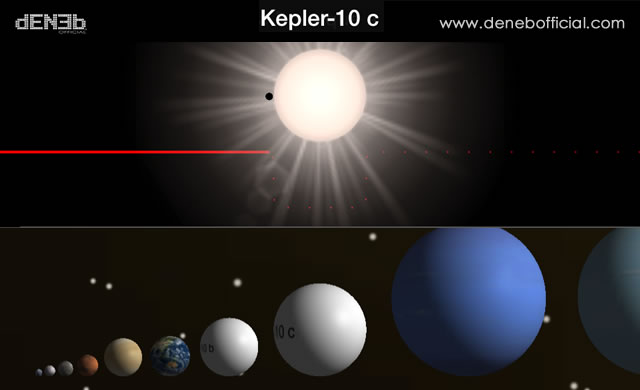
Grazie allo spettrografo HARPS che guarda nella stessa zona di cielo del satellite della NASA Kepler (intorno alla Costellazione del Cigno), gli astronomi del consorzio Italia-USA-Uk-Svizzera hanno potuto trovare un pianeta con una composizione simile alla Terra ma 17 volte più denso. Un pianeta denso di sorprese.
È quello individuato dal cacciatore di pianeti Harps-N, uno spettrografo di alta precisione installato al Telescopio Nazionale Galileo dell’Istituto Nazionale di Astrofisica a La Palma, nelle isole Canarie, da poco più di due anni. Grazie allo spettrografo HARPS che guarda nella stessa zona di cielo del satellite della NASA Kepler, gli astronomi del consorzio Italia-USA-Uk-Svizzera hanno potuto trovare un pianeta con una composizione simile alla Terra ma 17 volte più denso. Kepler-10c, questo è il nome, era stato scoperto dal satellite NASA Kepler che ne aveva anche misurato le dimensioni, pari a 2,3 volte quelle terrestri, ma solo grazie alle continue osservazioni del team di astronomi con lo spettrografo si è giunti alla determinazione della sua massa. Con questi dati Kepler-10c risulta essere un pianeta denso e roccioso come il nostro pianeta.
Fonte/Leggi tutto → Media.INAF.it
The Kepler-10 planetary system revisited by HARPS-N: A hot rocky world and a solid Neptune-mass planet – Kepler-10b was the first rocky planet detected by the Kepler satellite and con- firmed with radial velocity follow-up observations from Keck-HIRES. The mass of the planet was measured with a precision of around 30%, which was insufficient to constrain models of its internal structure and composition in detail. In addition to Kepler-10b, a second planet transiting the same star with a period of 45 days was sta- tistically validated, but the radial velocities were only good enough to set an upper limit of 20 Mearth for the mass of Kepler-10c.
To improve the precision on the mass for planet b, the HARPS-N Collaboration decided to observe Kepler-10 intensively with the HARPS-N spectrograph on the Telescopio Nazionale Galileo on La Palma. In to- tal, 148 high-quality radial-velocity measurements were obtained over two observing seasons. These new data allow us to improve the precision of the mass determina- tion for Kepler-10b to 15%. With a mass of 3.33 +/- 0.49 Mearth and an updated radius of 1.47 +0.03 -0.02 Rearth, Kepler-10b has a density of 5.8 +/- 0.8 g cm-3, very close to the value -0.02 predicted by models with the same internal structure and composition as the Earth. We were also able to determine a mass for the 45-day period planet Kepler-10c, with an even better precision of 11%. With a mass of 17.2 +/- 1.9 Mearth and radius of 2.35 +0.09 -0.04 Rearth, -0.04 Kepler-10c has a density of 7.1 +/- 1.0 g cm-3. Kepler-10c appears to be the first strong evidence of a class of more massive solid planets with longer orbital periods.
Source/Continue reading → arxiv.org





















